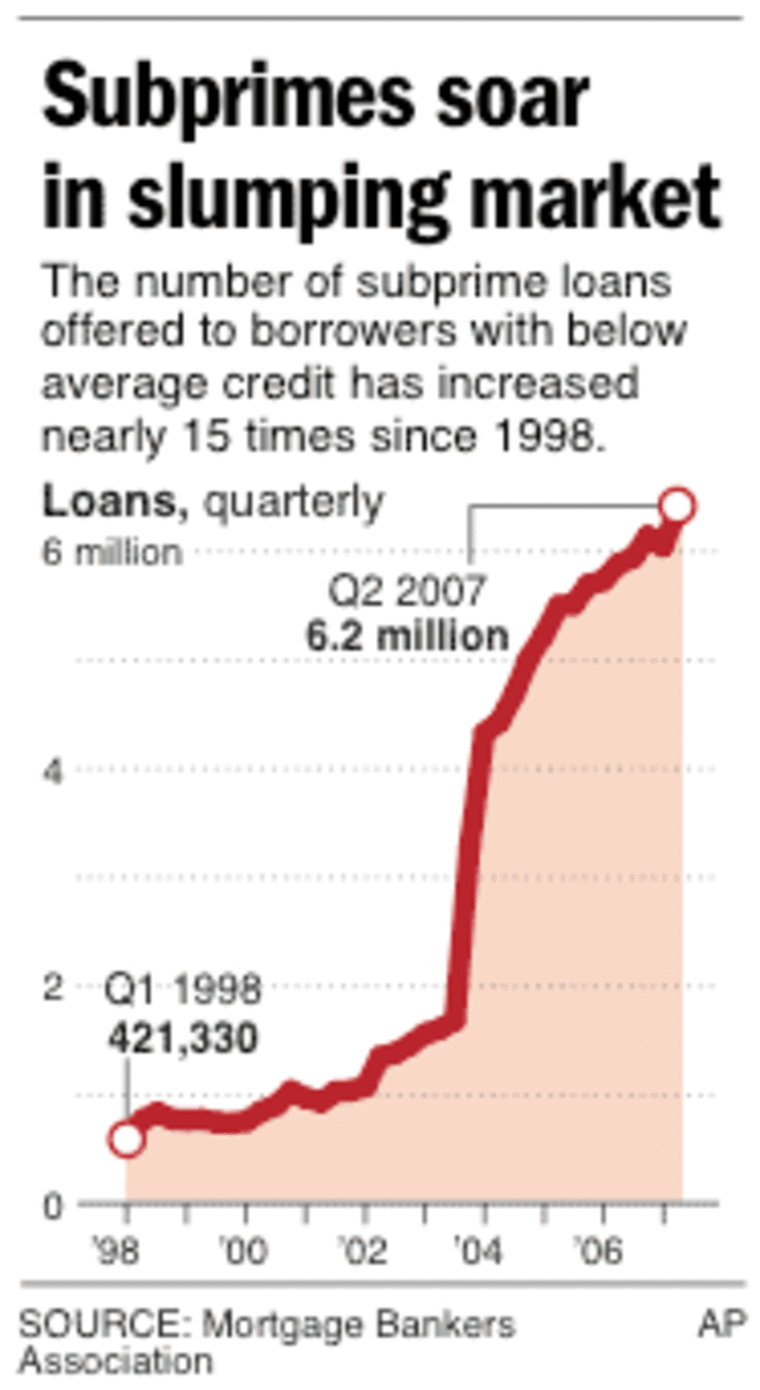Hundreds of thousands of strapped homeowners could get some relief from a plan negotiated by the Bush administration to freeze interest rates on subprime mortgages that are scheduled to rise in the coming months.
“There is no perfect solution,” President Bush said Thursday as he announced an agreement hammered out with the mortgage industry. “The homeowners deserve our help. The steps I’ve outlined today are a sensible response to a serious challenge.”
Bush has been accused of moving too slowly to address a crisis that has spread to the broader financial market. But he also was careful not to sound as if he were imposing a government solution and violating his free-market principles. He billed his plan as a voluntary, private-sector arrangement that involves no government money.
“We should not bail out lenders, real estate speculators or those made the reckless decision to buy a home they knew they could never afford,” Bush said after meeting with industry leaders at the White House. “But there are some responsible homeowners who could avoid foreclosure with some assistance.”
Bush said 1.2 million people could be eligible for help. But only a fraction will be subject to the rate freeze. Others would get assistance in refinancing with their lenders and moving into loans secured by the Federal Housing Administration, Bush said.
Also, the aid will only come to those who ask for it, he said. Thousands of borrowers who are falling behind on their payments have been sent letters about the options, and Bush also urged people to call a new hot line: 1-888-995-HOPE.

The announcement followed the news earlier Thursday that home foreclosures surged to an all-time high in the July-September period. The Mortgage Bankers Association reported that the percentage of all mortgages that started the foreclosure process in the third quarter jumped to a record 0.78 percent, surpassing the previous record of 0.65 percent of all mortgages in the second quarter.
The administration’s effort is aimed at stemming a further tidal wave of foreclosures in coming years as 2 million subprime mortgages — loans provided to borrowers with spotty credit histories — reset from their introductory rates of around 7 percent to 8 percent to levels as high as 11 percent, adding hundreds of dollars to the typical monthly payment.
A recent surge in mortgage defaults, part of the worst housing slump in more than two decades, has piled up billions of dollars in losses for big banks, hedge funds and other investors while roiling financial markets worldwide. Some economists think the housing bust may become severe enough to push the country into recession.
Bush originally gave the wrong number for the hot line; the White House later corrected him.
The president mentioned other steps to prevent foreclosures. The FHA has greater flexibility to offer refinancing to homeowners with good credit histories. It is expected that this eventually will help 300,000 families, officials said.
The Federal Reserve is announcing stronger lending standards this month, while the Housing and Urban Development Department and federal banking regulators are acting to improve disclosure requirements, he said.
Fed Chairman Ben Bernanke said the streamlined procedures for supporting efforts to refinance mortgages and freeze rates were a “welcome step in helping Americans protect their homes and communities from the consequences of unnecessary foreclosures.”
The highest-profile part of the plan would freeze introductory “teaser” rates on certain subprime mortgages, preventing rates from rising for five years.
This offer would apply only to people living in their homes and who have not missed any payments at the lower rate. It also only would apply to loans taken out between 2005 and this past July 30 and scheduled to rise to higher rates in 2008 and 2009.
The hope is that the five-year freeze will buy time for the housing sales and prices to start rising again. Such a rebound would enable homeowners to refinance their current adjustable rate mortgages into fixed-rate loans with more affordable monthly payments.
But even Treasury Secretary Henry Paulson, who led the negotiations with the mortgage industry, acknowledged the effort is “not a silver bullet.”
“We face a difficult problem,” he said.
The big sticking point in the negotiations was getting investors who had purchased the mortgages after they were bundled into securities to agree to accept lower interest payments. Critics have said even with a deal, there are likely to be lawsuits. But officials representing major players in the mortgage industry said they believed the plan would withstand any legal challenges and would help at-risk homeowners avoid defaulting on their mortgages.
But George Miller, executive director of the American Securitization Forum, which represents companies that package mortgages into mortgage-backed securities, told reporters he expected the industry would face suits from investors unhappy that the original terms of the mortgages have been modified.
The president also did not miss the chance to lash out at the Democratic-controlled Congress.
Bush blamed lawmakers for not sending him legislation that he said would show they “are serious about responding to the challenges in the housing market.” One measure would give the FHA more flexibility; a second would change the tax laws temporarily to help people who have a portion of their mortgage forgiven by banks.
“The Congress has not sent me a single bill to help homeowners,” Bush said.